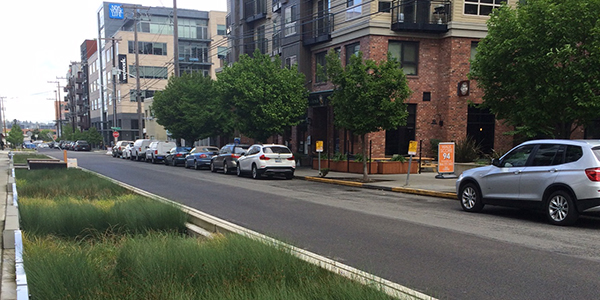Photo credit: Seattle Public Utilities
Rain falls on a city – but instead of running off into a storm drain, it flows into a curbside rain garden, off a roof into a cistern, or is absorbed into vegetation planted on roofs.
What is this called?
Storm drains and pipes are known as grey infrastructure – there’s no debate about that. But techniques for managing rain where it falls, including rain gardens, bioswales, infiltration galleries, green roofs and cisterns are known by many names.
In the Umbrella bulletin, we tend to use the terms green infrastructure or green stormwater infrastructure – terms that emphasize the economic value of the ecosystem services they provide. But other terms are also popular in Ontario. These include Low Impact Development (LID), stormwater innovations, or source controls (these terms, along with green infrastructure, can all be found in government policies and reports). In the rest of Canada and the world other terms are popular – sustainable rainwater management practices, sustainable urban drainage systems and water-sensitive urban design are just a few others.
The multitude of terms can lead to confusion when discussing stormwater with different stakeholders. Some people may be familiar with one of these terms and be unaware that others refer to the same thing. Those new to the issue do not find the terminology very descriptive. Low impact development, for example, is very popular among the engineering and consulting sector, but it would be quite hard to make an educated guess at its meaning if you weren’t familiar with the term. Shortening it to LID makes it even harder to guess at.
As a term, green infrastructure has its shortcomings as well. This term is commonly used by the USEPA, but there is a disagreement about whether it should refer specifically to stormwater infrastructure, or to other kinds of ecosystem services as well (such as carbon sequestration and air quality improvements). The Canadian government has used the term in a completely different way- the Green Infrastructure Fund was for projects that benefited the environment—most of the money was used on wastewater treatment plants, and almost none went towards what we would refer to as ‘living’ green infrastructure.
It is important for those of us working together on this issue to come to an agreement about what words to use, at least when making public statements and advocating for policy change. Managing rain where it falls requires a transformation of culture and the urban landscape, and we need to articulate what we want to see happen.
A blue-green city is a term that has been used in the U.K. to illustrate this vision. Could this be a way of describing what we want: to transform Canada’s urban areas into blue-green cities?
This article was published in The Umbrella Stormwater Bulletin Issue 41.
Poll
If all Canadians were to adopt one term for managing rain where it falls, what should it be?
- Green infrastructure/green stormwater infrastructure (26%, 11 Votes)
- Low Impact Development (14%, 6 Votes)
- Source controls (5%, 2 Votes)
- Best Management Practices (2%, 1 Votes)
- Stormwater Innovations (2%, 1 Votes)
- Sustainable urban drainage systems (2%, 1 Votes)
- Sustainable rainwater management practices (26%, 11 Votes)
- Water-sensitive urban design (12%, 5 Votes)
- Blue-green cities (5%, 2 Votes)
- Other?? (7%, 3 Votes)
Total Voters: 43


